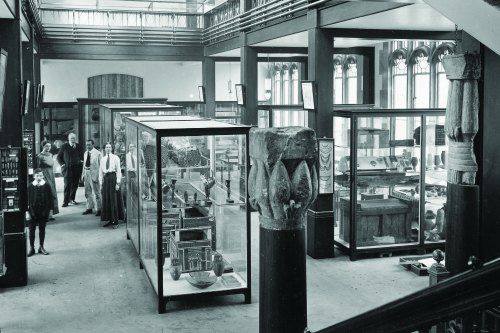Manchester Museum
The Museum was opened in 1887 to house collections that had belonged to the Manchester Natural History Society, whose museum in the city centre had closed c. 1872.

The museum's collections originated with Manchester enthusiasts for natural history, notably the early textile industrialist, John Leigh Philips (1761-1841). The Manchester Society for the Promotion of Natural History was formed in 1821 with the hope of displaying Philips's and other private natural history collections. By 1835 they had opened a new building on Peter Street; this was extended in the early 1850s to include the collections of the Manchester Geological Society. From 1835 to 1838 William Crawford Williamson, a young Yorkshire naturalist and geologist, was employed as manager and curator – the start of his long career in Manchester, mixing natural history and medicine.
The museum charged for the admission of non-members, including the working classes, but by the 1860s the middle-class membership was falling. The museum first looked to local government for support, but it was Owens College, founded in 1851, which agreed to take the collections.
There was no room for them in the College's Quay Street building, and even after the college moved to Oxford Road in 1873, there was display room only for geology.

By 1887, however, the college's supporters had funded and built a large gothic museum, at the front of the college quadrangle. It connected with the Beyer Building which housed geology and zoology and botany, and, like the other college buildings, it was designed by Alfred Waterhouse. Thomas Henry Huxley had advised on the principles of the building, while William Boyd Dawkins had developed the galleries, first as curator to the Natural History Society and then as Professor of Geology at the college. The new galleries were to be used by college staff and students, but they were also open to the public. The Manchester Museum has been extended several times, usually to accommodate new kinds of collections.
Boyd Dawkins was famous as a palaeontologist, but also as an archaeologist of early man. The museum displayed human remains alongside the fossils of mammals, while other anthropological material was included to indicate the stages in the civilisation of humankind. Various specimens were added by local collectors, one of whom, the Bolton yarn merchant Jesse Howarth, became interested in ancient Egypt. He supported the excavations of Flinders Petrie and in return received some of the finds, which he loaned to the Manchester Museum. There was little room for them, but Ancient Egypt became very popular, and when Howarth offered money for a new gallery, the museum agreed. This first, two-storey extension was designed by Paul Waterhouse, son of Alfred, and opened in 1912.

The magnificent Egyptian collections, together with some Assyrian material, underlined the relative poverty of the holdings in anthropology and classical archaeology – for which new galleries were then provided in 1927. Funded partly by Howarth and designed by Michael Waterhouse, grandson of Alfred, it rose to five storeys, complementing the towers of the original building.
The latest large extension came in 1977 when the museum acquired the premises vacated by the University Department of Metallurgy. This Edwardian baroque building had been designed in 1908 by Charles Heathcote and Sons as the Dental Hospital. In 2003 the Museum opened a new entrance building, off Coupland Street, and the Café Muse was developed in the former Dental Hospital building.
An ambitious rolling programme of gallery renewal continues to keep the museum fresh and engaging.
